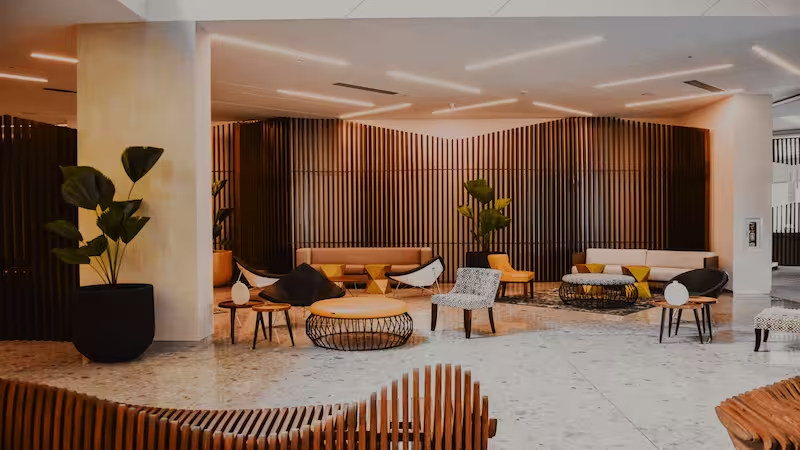
Table of Content
What is Visual Merchandising?
Visual merchandising is the art of strategically displaying products in a store to attract people and boost revenue. It involves a fastidious arrangement of products, signage, and displays to capture customers' attention. The main purpose of this marketing approach is to appeal to consumers' senses and emotions to draw their attention to specific products or retail areas.
The Power of Visual Merchandising
Visual merchandisers employ aesthetics, design, and psychology to create an interactive experience. Eye-catching visuals can help increase a customer’s message retention by 42% and increase revenue by 15-30% in the long run. Apple is an excellent example of a store that uses inventive visual marketing practices. This company provides a unique experience that taps into emotions rather than just presenting products. The product displays are sleek and simple, with well-thought-out lighting and spacious arrangements that encourage shoppers to interact with the technology. Apple stores also include interactive features like product demonstrations and workshops to further engage customers. Because of this, Apple routinely rates highly in terms of retail sales per square foot, demonstrating how well their visual merchandising strategy works to increase sales and consumer engagement. Visually appealing displays can turn window shoppers into buyers. It silently but persuasively conveys the brand's personality, values, and product essence. Effective visual merchandising involves analyzing consumer behavior and employing this information to promote products' characteristics, upsides, and unique selling points. An ideal combination of design, storytelling, and emotional stimulation can pique interest and persuade potential customers, leaving a lasting impression.
Tips for Creating Outstanding Visual Merchandising Displays

Excellent visual merchandising displays are akin to telling a story that piques interest and influences customers' shopping experiences. A comprehensive awareness of numerous crucial factors is needed to create attention-grabbing store narratives. Below are ideas that can turn standard displays into immersive experiences to encourage people to explore, engage, and buy.
Understanding Your Target Audience
When creating captivating visual merchandising displays, it is crucial to have a comprehensive analysis of potential clients' demographics, psychographics, and buying habits. This understanding helps create visuals that appeal to their needs, making the environment more relatable and appealing. For instance, younger audiences may prefer vivid, modern setups with interactive features, while elderly audiences may prefer refined, classic sets. Tailoring settings to your audience's tastes and inclinations creates a familiar environment that encourages product engagement. According to Segment’s survey, 44% of customers are more likely to return to a retail store after a personalized shopping experience.
Storytelling Through Displays
A fascinating tale can instantly transform a simple shelf arrangement into an immersive and memorable customer experience. Consider the product's origins, production, and purpose and showcase this journey through visual elements to engage with shoppers. A display of ethically sourced and locally created objects could include photographs or information about the artists and their traditional craftsmanship, appealing to shoppers seeking authenticity and originality. Creative displays can transport customers to different times and places. By engaging several senses and evoking emotions, storytelling through displays improves the shopping experience, encouraging shoppers to stay longer, explore, and purchase.
Strategic Use of Colors
The strategic employment of colors can influence shoppers’ emotions and behavior in stores. Comprehending how colors affect human psychology can help you influence customers’ buying decisions. For example, warm hues like reds and oranges are good for clearance discounts and limited-time bargains because they inspire impulse buying. Matching colors to your brand identity is also crucial. Color consistency across displays and branding materials boosts brand recognition. Colors that match your brand create a unified and visually appealing setting and assist in building a strong brand identity that buyers can relate to.
Additionally, your UX colors should adhere to the 60-30-10 rule when using color to create visual interest and balance. About 60% of the design should consist of a more neutral color in your palette, 30% will be a complementary color, and the final 10% will be an accent color. Contrast is a crucial element that you should take into account when choosing your color scheme as you can direct attention to the desired areas. You can use high contrast to draw attention to buttons and other navigational elements, and medium contrast for content you want customers to read.
Lighting and Its Impact

Lighting is a visual merchandising unsung hero that influences consumer behavior. Beyond illuminating the products, it sets the mood and draws attention. Effective lighting can highlight specific areas in the store and evoke emotions. Properly lit displays grab attention and improve product aesthetics. Find the right mix between emphasizing the merchandise and creating an appealing store. Using energy-efficient and eco-friendly lighting cuts expenses and matches modern consumer ideals, creating a favorable brand image that cares about sustainability and the environment.
Incorporating Digital Signage
Digital signage has revolutionized the visual merchandising landscape. The technology’s dynamic abilities allow interactive displays to attract tech-savvy consumers. A reliable digital signage software Look DS can modernize and add an innovative touch to your retail space, from interactive touchscreens delivering product information or virtual experiences to high-definition video displays highlighting product characteristics. Digital signage for retail stores allows you to create real-time updates, making it easier to promote new products and keep up with market trends, which ensures your displays are fresh and entertaining.
Creating Focal Points
Creating emphasis points in your visual merchandising displays can help guide client attention and streamline the buying experience. Focal points make it easier for shoppers to see the newest arrivals and popular items, which makes the store feel lively and dynamic. Imagine a retail setting where a well-lit, strategically placed display offers a well-chosen assortment of the newest arrivals. A distinctive or highlighted object at eye level or with specific lighting can entice customers into further exploring the exhibit. Contrasting colors, sizes, and positioning can encourage customers to check out the display. Fashion retailer Zara is well-known for its creative use of visual merchandising. If you enter any Zara store, you'll probably notice that the room is filled with well-placed focal points. One example of a focal point could be a well-lit display at the entryway with the newest, perfectly styled, trend-driven goods that draw customers in.
To encourage clients to explore the store more, Zara uses contrasting colors, various product heights, and a dynamic visual design. The brand uses mannequins wearing the newest trends in clothing to create a strong focal point that directs customers to particular collections or draws attention to important pieces. Visual hierarchy—larger goods at the back and smaller ones at the front—guides customers' eyes from one focal point to another, ensuring they don't miss crucial products or promotions while maintaining an attractive arrangement.
Consistency and Brand Identity
Visual merchandising consistency should not appear on individual displays; it should run across the entire store. A consistent theme throughout your business can strengthen your brand and create a lasting impression. Your store’s theme should reflect your brand's values and mission, from color, font, and design to layout. This consistency builds trust among your clients, helping them to connect with your brand more deeply. Your visual merchandising displays should match your brand's message and reinforce your brand's eco-friendliness, elegance, or affordability. Customers are more inclined to trust and remain loyal to your brand if they perceive a harmonious blend of its values in your business, boosting sales and retention.
Elevating Retail through Effective Visual Merchandising
Visual merchandising displays are crucial in a constantly evolving business landscape where competition is steep, and consumer attention is indispensable. These displays showcase a brand's identity, beliefs, and objectives, connecting it with its clients. In an age of growing online buying, the in-store experience is crucial. Visual commerce displays connect the digital and physical worlds, providing a sensory experience that cannot be replicated online. As technology advances and consumer tastes change, display visual merchandising becomes more important for keeping relevant and attracting and retaining customers. Carefully selected displays are more than visual treats—they're silent sales pitches that may impact consumer behavior, build brand loyalty, and drive sales, making them essential to a successful retail strategy.




.avif)



